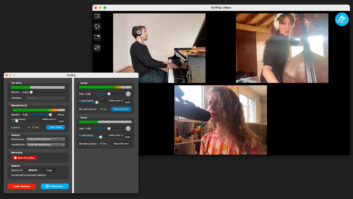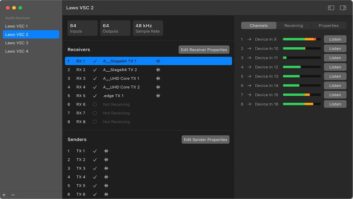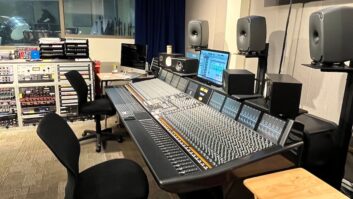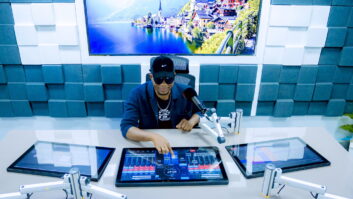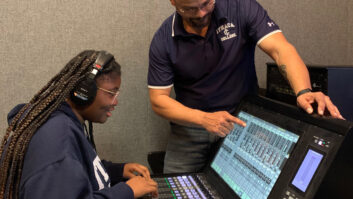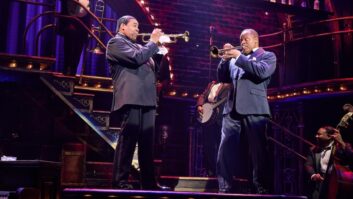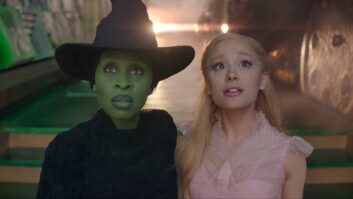Shelbie Rassler, a senior at Boston Conservatory at Berklee, already had plans and a plane ticket to spend spring break in Fort Lauderdale when talk began of a virus spreading around the world. Unfortunately, she wouldn’t need the return ticket. She’d be spending the rest of her last year of college at home with her family in Florida.
Like all colleges and universities in the United States, Boston Conservatory sent its students home in the wake of the coronavirus crisis. Before she left for home, the school had announced that classes would be moving online on March 23 and would continue to operate remotely through the end of the semester. Even her commencement ceremony and the celebratory pre-graduation music, dance and theater tribute will be virtual this year.
Rassler posted the video “What the World Needs Now Is Love” on March 22.
The world changed dramatically in March and most of us are still trying to find our place in the online work and education spaces we’re building in this time of uncertainty. While physically distant, we’re finding ways to produce, create and collaborate through webcams, smartphones and video conferencing apps, Facebook posts and email.Rassler has responded through music, appropriate since she’s pursuing a bachelor of music degree in composition at Boston Conservatory.
She made the most of spring break 2020 in Florida. Instead of sand, surf and sun, however, she spent the week at home. While she was physically self-isolating, she still found a way to bring her creative community together.
Her idea, sparked on the flight home, was to create a virtual music video, which she’d begin and complete in the one week between the end of physical classes on March 13 and the beginning of virtual ones on March 23. True to her word, she posted the finished project on March 22.
Rassler produced and edited a video in which more than 70 artists perform the 1965 Burt Bacharach/Hal David song “What the World Needs Now Is Love,” which she believed was an appropriate goal for life in the time of pandemic. “I felt as though this song has the perfect message to bring some hope and positivity to the world right now,” Rassler said in an email. “My friends and I were absolutely devastated to leave Boston, and I felt as though this song could have the power to reunite us all in a beautiful, creative way.”
Participants and her mix engineer are drawn from Rassler’s group of friends and classmates, who responded to her request for help: “Artist friends please read!!! Let’s do a thing!!!”
She put out the call on Facebook the evening after her flight home, asking her extended social circle—“Calling all singers, instrumentalists, musicians, dancers, artists who are friends of friends of friends!”—to commit to recording audio and video of themselves performing the song, which she’d produce, arrange and edit into a virtual orchestral work.
Rassler’s idea to make a collaborative video of this song was inspired in part by the Broadway for Orlando effort recorded after the Pulse nightclub shooting in June 2016.
“After I sent the email to all who were interested (almost 200 people), I received 75 final responses. Most of the people in the video are friends and classmates, with a few additional friends of friends who saw my post and were interested,” Rassler said, adding that among the singers are her mother, a singing teacher, and her sister.
She left it up to the participants to decide whether they’d sing, dance or play an instrument. She explained, “As soon as I had a list of individuals and what instruments they’d play, I wrote the orchestral arrangement of ‘What the World Needs Now’ and exported the sheet music and a MIDI mockup track for my friends to play along to.”
Providing a track for everyone to reference while performing was crucial to the success of this project, which called for 75 artists to play together while separated by both time and location. Without a conductor of some sort, the performance could easily devolve into chaos.
Rassler noted, “I think the most important logistical aspect of creating something like this is providing a reference track for everyone to listen to while recording their individual parts. Without a track, it would have been near impossible to sync several videos together in this way.”

The final video includes 41 vocalists, seven dancers and 27 instrumentalists playing instruments including piano, electric bass, violin, trombone, accordion, flute, cello, bassoon, harp and French horn, with Rassler herself on alto sax.
While it was unfortunate that she wouldn’t be able to perform with her friends and colleagues in person, internet speeds made it unavoidable. “Due to latency issues on live recordings, I knew from the beginning that I would ask the participants to send me separate recordings that they created remotely on their own time.”
Like Rassler and approximately three-quarters of the world’s population, participants were practicing social distancing. She asked them to record wherever and with whatever technology was available to them. A look at the video shows musicians performing in bedrooms, offices, living rooms and bathrooms. There’s not a single recording studio or acoustic treatment in sight.
Rassler noted, “The majority of my friends used their smartphones to record the video, and a separate device (mostly laptops) to simultaneously listen to the track. A few people used external microphones and an audio interface to connect to their laptops.”

To aid in video editing, she had everyone record the song all the way through, not just the parts where they were actually performing. “This made the syncing and editing process much easier moving forward.”
Vocalists and musicians appear on screen whenever the arrangement calls for them to perform, resulting in a tiled mosaic of heads and instruments. Rassler didn’t think to specify that participants record video in a horizontal aspect ratio; not surprisingly, she received both vertical and horizontal video submissions.
CNN’s Daily Coronavirus Podcast Beats Production Challenges, by Jim Beaugez, April 3, 2020
While the end result is satisfyingly symmetrical, Rassler said it was difficult juggling the imagery to fit, especially in the sequences with many musicians playing at the same time. If she were to do this again, she’d require everyone shoot horizontally, which would have made video editing less of a puzzle.

Rassler did the audio editing in Apple Logic Pro X and edited the video in Apple Final Cut Pro. She brought on assistance in the form of mix engineer Dan Santiago, who did audio mixing in Avid Pro Tools.
Santiago is a Contemporary Writing and Production/Professional Music dual major at Berklee College of Music. He and Rassler have known each other for a bit and have worked together on several projects, “though usually, I’m playing drums and she’s conducting,” he said. He got involved with this project after he saw Rassler’s Facebook post. He says he texted her about it and then she asked him to mix it.
Santiago’s greatest challenge was getting the audio recorded in such a variety of spaces to sound consistent. He explained in an email, “I did a ton of processing to get the recordings to sound more cohesive. I was going for the feel of being in front of a live orchestra the best I could, so everything is going to the same Hall (Valhalla Vintage Verb) and there was a lot of EQ work to be done to get rid of the disruptive frequencies coming through each individual recording. I probably have close to 30 slightly different EQs in that session. I used a few plug-ins several times—I’m a student, so I’m working with what I’ve got over here, haha—the main ones being the SSL EQ and REQ 6 from Waves, some stock Pro Tools plug-ins, the Valhalla Vintage Verb and Native Instruments’ Guitar Rig for the Electric Guitar Tone.”

About his hardware, he added, “At the moment I’m running a pretty basic setup with a pair of Yamaha HS7s running through my UAD Apollo Twin. I like to check things in headphones every now and then so I used a pair of ATH-M50xs to do that.”
The first step in balancing all the audio clips so they sounded more cohesive, Santiago said, was “getting all the vocals to have a similar level pre-fader. So I went in and adjusted clip gain until all the audio tracks were as close in level as possible, taking into account that a few of them were clipping and couldn’t be adjusted much. From there, it was a matter of scooping out as much room noise as I could with EQ. This process took hours because a lot of the rooms needed different EQs to get the noise out without ruining the sound of the instrument or voice.”
The mixing process here wasn’t substantially different than other projects he’s worked on. “My workflow was the same as my usual process. I typically like to work from the bottom up on the instruments (bass, drums, keys, guitar, strings, etc.) and then add the vocals after I’ve gotten the instruments to sit where I want them with each other,” Santiago explained. “From there, it was just a matter of making room for the lead lines and fitting the choir in somewhere between the two.”

While mixing audio and editing picture were each a bit of a puzzle, formats and resolutions were a breeze. “Since almost all of the videos were taken on iPhones, it wasn’t too challenging to conform everything to the project’s resolution. Final Cut Pro did the heavy lifting for that,” Rassler explained.
Santiago agreed, noting that the majority of participants “just propped their phones up and sang/played into their headphone cables or directly to their phones.” He added that because most of the videos were recorded using smartphones and earbud/AirPods microphones, “that kept a lot of the submissions fairly uniform in terms of the sample rate. The rest, fortunately, were recorded in 44.1 kHz 16-bit so no problems there.”
Rassler’s prowess with Final Cut is thanks to ingenuity and the internet. “I have taught myself everything I know about audio recording and mixing, with the help of various YouTube tutorials.”

She’s pleased that the song’s challenging tempo and key changes came through in the edit. “I am particularly happy with how the modulation came together, beginning at about 1:59 in the video. This was the most challenging section of the piece, as there is a modulation and a rallentando at the same time, without the aid of following a conductor. I was really thrilled that all of the parts were able to sync together in a cohesive manner.”
Finneas on Producing Billie Eilish’s Hit Album in His Bedroom, by Steve Harvey, Jan. 28, 2020
Rassler sent material out to participants—sheet music and a reference track—on March 16 and asked them to send in their videos by March 20. Two days later, on March 22, she posted the edited final online.
“The response from the video has been absolutely unbelievable,” Rassler said. “I feel so grateful that the video has spread all around the world and has provided a sense of hope and optimism during this challenging time. Many of my professors have reached out and said they saw it on television and are very proud of what my colleagues and I created together.”
https://www.facebook.com/shelbie.rassler/videos/2972016352862248/UzpfSTUwMDE1MDA3MDoxMDE1Nzg0NjA0NjYzMDA3MQ/?comment_id=Y29tbWVudDoyOTM3NzMwMDk5NjI0MjA3XzI5MzgwOTAzMTI5MjE1MTk%3D
Rassler has enjoyed outsized success since sharing her project with the world. She and her viral video have been featured in print and online in outlets including NPR, NBC’s Today, Canada’s CTV News, Forbes magazine and USA Today. She got an Instagram shout-out from Jessica Chastain, and Barbra Streisand gave her project a “Bravo!” on Facebook. Even Burt Bacharach was impressed, noting in an interview on Today, “You guys did great!”
Not all of her success is merely social. As this article went to press, Rassler learned she’d been accepted into the Master of Music program at Juilliard for the 2020-21 academic year. She said in a post on Facebook, “My life has changed in more ways than I ever thought possible in the past two weeks…. All of my dreams have come true and I could not be more grateful.”
What does she most look forward to once this crisis is over? “I am most excited to spend time with my friends and make music together—in person this time!”
Shelbie Rassler • maestramusic.org/profile/shelbie-rassler
Dan Santiago • @dansantiago.wav
